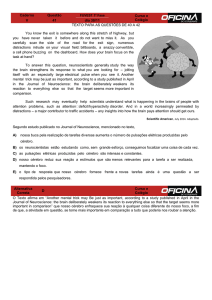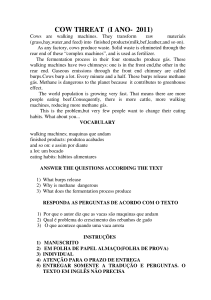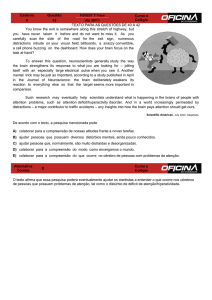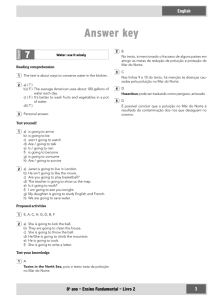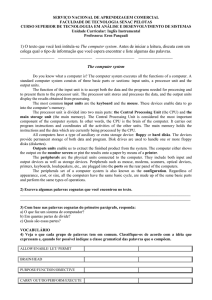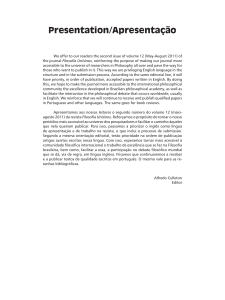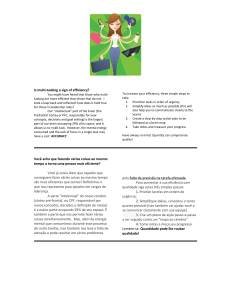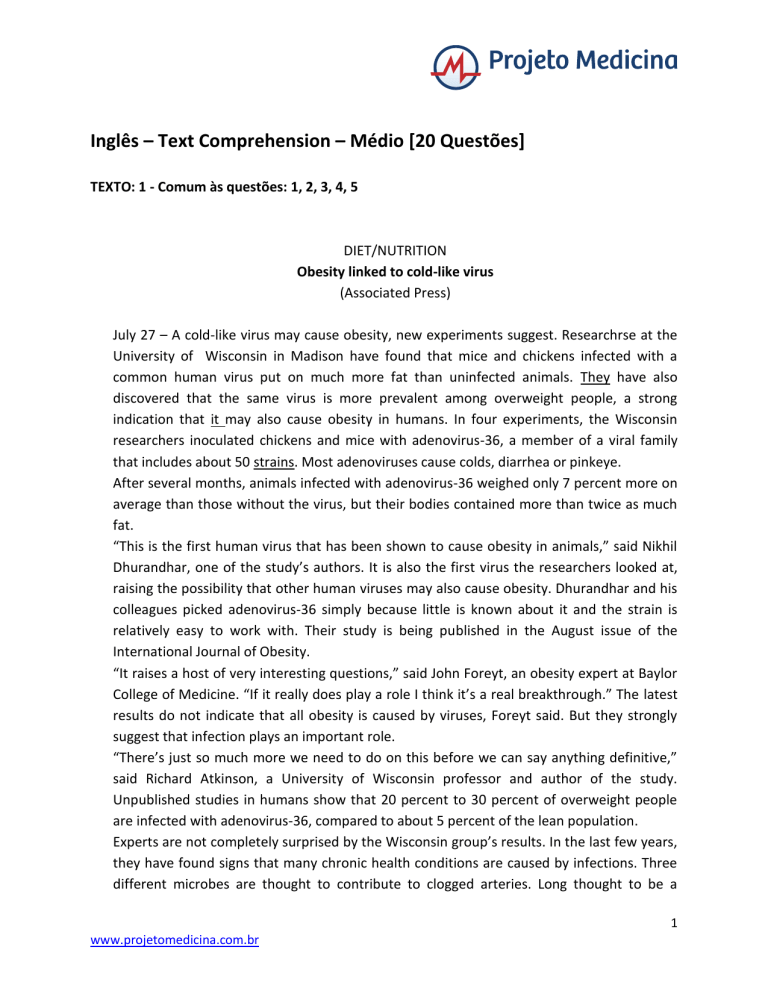
Inglês – Text Comprehension – Médio [20 Questões]
TEXTO: 1 - Comum às questões: 1, 2, 3, 4, 5
DIET/NUTRITION
Obesity linked to cold-like virus
(Associated Press)
July 27 – A cold-like virus may cause obesity, new experiments suggest. Researchrse at the
University of Wisconsin in Madison have found that mice and chickens infected with a
common human virus put on much more fat than uninfected animals. They have also
discovered that the same virus is more prevalent among overweight people, a strong
indication that it may also cause obesity in humans. In four experiments, the Wisconsin
researchers inoculated chickens and mice with adenovirus-36, a member of a viral family
that includes about 50 strains. Most adenoviruses cause colds, diarrhea or pinkeye.
After several months, animals infected with adenovirus-36 weighed only 7 percent more on
average than those without the virus, but their bodies contained more than twice as much
fat.
“This is the first human virus that has been shown to cause obesity in animals,” said Nikhil
Dhurandhar, one of the study’s authors. It is also the first virus the researchers looked at,
raising the possibility that other human viruses may also cause obesity. Dhurandhar and his
colleagues picked adenovirus-36 simply because little is known about it and the strain is
relatively easy to work with. Their study is being published in the August issue of the
International Journal of Obesity.
“It raises a host of very interesting questions,” said John Foreyt, an obesity expert at Baylor
College of Medicine. “If it really does play a role I think it’s a real breakthrough.” The latest
results do not indicate that all obesity is caused by viruses, Foreyt said. But they strongly
suggest that infection plays an important role.
“There’s just so much more we need to do on this before we can say anything definitive,”
said Richard Atkinson, a University of Wisconsin professor and author of the study.
Unpublished studies in humans show that 20 percent to 30 percent of overweight people
are infected with adenovirus-36, compared to about 5 percent of the lean population.
Experts are not completely surprised by the Wisconsin group’s results. In the last few years,
they have found signs that many chronic health conditions are caused by infections. Three
different microbes are thought to contribute to clogged arteries. Long thought to be a
1
www.projetomedicina.com.br
product of high stress and a poor diet, ulcers are now known to be caused by the bacterium
Helicobacter pylori. In addition, several animal viruses are already known to cause obesity in
both animals and humans. But adenovirus-36 is the first human virus known to cause an
increase in fat. Researchers do not know yet how adenovirus-36 causes obesity. Infected
animals did not eat more than uninfected ones, suggesting that the virus decreases energy
expenditure rather than increasing appetite. “I feel that it increases the number of fat cells,
which encourages them to store more fat,” said Dhurandhar, who recently joined Wayne
State University in Detroit.
The animal obesity viruses appear to work differently from adenovirus-36, by damaging the
part of the brain that controls appetite. The Wisconsin researchers saw no brain damage in
chickens and mice infected with adenovirus-36. Aside from a day or two of cold-like
symptoms, Atkinson said, the virus produced no observable effects besides obesity.
Paradoxically, animals infected with the virus also had decreased levels of cholesterol and
triglycerides in their blood. Generally, obesity is associated with high cholesterol and
triglyceride levels.
Far more research is needed before any practical benefits can be reaped from this research,
Atkinson said. It is still too early to know whether it may be possible to develop an effective
vaccine against obesity or otherwise counteract the effects of the virus.
(MSNBC’s Diet and Nutrition archive)
01 - (UFMogi das Cruzes MG)
De acordo com os resultados das pesquisas, é possível afirmar que
a) os animais infectados com o adenovírus-36 passaram a comer mais, o que sugere que o
vírus leva a um aumento de apetite.
b) a obesidade nos animais infectados com o adenovírus-36 levou a um aumento nos
níveis de colesterol e triglicérides dos mesmos.
c) os animais obesos infectados com o adenovírus- 36 apresentaram danos na parte
cerebral que controla o apetite.
d) os animais infectados com o adenovírus-36 tiveram uma queda no seu gasto de energia.
e) os animais infectados com o adenovírus-36, embora tenham sofrido um aumento de
apetite, tiveram seus níveis de colesterol e triglicérides diminuídos.
02 - (UFMogi das Cruzes MG)
De acordo com o texto, pode-se afirmar que os experimentos científicos sugerem que
a) o mesmo vírus, que causa resfriados em seres humanos, pode causar obesidade em
animais.
2
www.projetomedicina.com.br
b) um vírus parecido com o que causa resfriados pode levar seres humanos e animais à
obesidade.
c) um vírus parecido com o que causa resfriados em seres humanos provoca um aumento
de peso em ratos e frangos.
d) o vírus causador de resfriados está ligado à obesidade tanto em seres humanos quanto
em animais.
e) o vírus que causa resfriados em seres humanos é o mesmo que causa diarréia e
aumento de peso em ratos e frangos.
03 - (UFMogi das Cruzes MG)
Os vocábulos grifados no primeiro parágrafo referem-se a
a) pesquisadores – vírus – membro da família viral
b) animais – indicação – membro
c) pesquisadores – vírus – vírus
d) animais – vírus – família viral
e) pesquisadores – indicação – membro da família viral
04 - (UFMogi das Cruzes MG)
De acordo com o texto está INCORRETA a seguinte afirmativa.
a) Com base nas pesquisas, ainda não se pode afirmar que será possível desenvolver uma
vacina eficaz contra a obesidade.
b) Resultados de experimentos científicos demostram que a obesidade pode estar ligada a
infecções.
c) A maioria dos adenovírus causam resfriados, inflamação do globo ocular e diarréia.
d) Já foram publicados estudos mostrando que de 20 a 30% da população acima do peso
normal estão infectados com o adenovírus-36.
e) Os pesquisadores ainda não foram capazes de identificar como o adenovírus-36 causa
obesidade.
05 - (UFMogi das Cruzes MG)
De acordo com o texto, é correto afirmar que após um longo período de observação os
pesquisadores descobriram que
a) os animais inoculados com o vírus pesavam muito mais que os animais não infectados.
b) a quantidade de gordura corporal quase duplicou nos animais infectados com o vírus.
c) apenas 7% dos animais infectados não haviam sofrido mudança de peso.
d) os animais infectados com o vírus pesavam, em média, apenas 7% a mais que os não
infectados.
3
www.projetomedicina.com.br
e) apenas 7% dos animais sofreram um aumento de peso e de quantidade de gordura no
corpo.
TEXTO: 2 - Comum às questões: 6, 7, 8, 9
By Cathy Newman Photographs by Steve McCurry
Her eyes have captivated the world since she appeared non our cover in 1985. Now we
can tell her story
Get a taste of what awaits you in print from this compelling excerpt.
Names have power, so let us speak of hers. Her name is Sharbat Gula, and she is Pashtun,
that most warlike of Afghan tribes. It is said of the Pashtun that they are only at peace when
they are at war, and her eyes—then and now—burn with ferocity. She is 28, perhaps 29, or
even 30. No one, not even she, knows for sure. Stories shift like sand in a place where no
records exist. Time and hardship have erased her youth. Her skin looks like leather. The
geometry of her jaw has softened. The eyes still glare; that has not softened.
http://mesa.nationalgeographic.com/ngm/afghangirl/index.html
The young Afghan refugee who stared from the cover of National Geographic in June 1985
was an enigma for 17 years. What was her name? Had she survived? This past January
photographer Steve McCurry joined a crew from National Geographic Television & Film to
methodically search for her.
4
www.projetomedicina.com.br
They showed her photograph around the refugee camp in Pakistan where McCurry had
encountered her as a schoolgirl in December 1984. Finally, after some false leads, a man
who had also lived in the camp as a child recognized her. Yes, she was alive. She had left the
camp many years before and was living in the mountainous Tora Bora region of
Afghanistan. He said he could find her, and three days later he and a friend brought her
back to the camp. There, the remarkable story of this woman, Sharbat Gula, began to be
told.
http://mesa.nationalgeographic.com/ngm/afghangirl/zoom1.html
Portrait of a Survivor
Photograph by Steve McCurry
06 - (UFRN)
A idade exata de Sharbat Gula é uma informação
a) cuja divulgação é proibida.
b) registrada em cartório.
c) somente conhecida por ela.
d) difícil de ser confirmada.
07 - (UFRN)
O que permanece inalterado em Sharbat Gula é a
a) intensidade do olhar.
b) fibra do cabelo.
c) textura da pele.
d) geometria do queixo.
08 - (UFRN)
Steve McCurry
a) passou dezessete meses pesquisando a vida de uma desconhecida.
b) participou de uma mostra fotográfica sobre cinema e televisão.
c) organizou uma pesquisa escolar em um acampamento paquistanês.
d) fotografou uma mesma pessoa em dois momentos distintos.
09 - (UFRN)
A fotografia publicada em junho de 1985
a) foi feita na região montanhosa de Tora Bora.
b) retratou uma jovem afegã de dezessete anos.
5
www.projetomedicina.com.br
c) serviu de base para encontrar Sharbat Gula.
d) lançou profissionalmente a moça da capa.
TEXTO: 3 - Comum às questões: 10, 11
Superstitions
Since I am not a superstitious person myself, I’m always amused when other people
behave1 superstitiously2. In fact, when I was young and wanted to drive3 my mother crazy, I
would open an umbrella in the house. As a child, I could never understand4 why her5
reaction was so extreme. To tell6 you the truth, I still haven’t been able to figure out why
opening a brolly7 indoors is supposed to bring bad luck.
Some superstitions can be traced back to ancient religions. Take the number 13, for
example. Some people are so superstitious about it15 that they will avoid having thirteen
people at a table at all costs. In America, some well-known hotels have no rooms or floors
numbered 13. Scholars say this superstition came from Scandinavia. According to a Norse
myth, twelve gods and goddesses were having a feast when the evil god Loki joined them
uninvited. This caused an argument, which resulted in the death of Balder, the most
beloved of all the Norse gods.
However, this explanation sounds illogical to me. I find it hard to believe that people are still
so strongly8 affected by something which9 never really happened.
A more recent superstition is the belief that lighting three cigarettes in a row with one
match is unlucky. This strange belief has its10 roots in the Boer War, which took place in
South Africa between the British and the Afrikaners at the end of the nineteenth century.
The Afrikaners could kill three soldiers who had just lit their 11 cigarettes with the same
match. At least the explanation to this superstition sounds more realistic than an old fairy
tale.
However, not all superstitions have to do with bad luck. Horseshoes, for example, are
thought to be lucky. These objects are probably associated with good luck because in
ancient times making iron into something useful was regarded as magic. Another
explanation might be that the horse was a sacred animal for the Celtic people of Europe.
Even Admiral Nelson nailed a horseshoe to the mast of his ship to bring 12 good weather and
calm seas on his journeys.
Whatever the explanations for superstitions are, none of them sound totally 13 convincing to
me. But then again, that is exactly14 the reason why these beliefs are considered
superstitions and not science.
6
www.projetomedicina.com.br
(Source: MITCHELL, H. Q.; SCOTT, J. Channel your English.
Intermediate. Students´ book. London: MMPublications, 2002.
10 - (UFV MG)
According to the text, it is CORRECT to say that the author:
a) used to believe in superstitions when he was young.
b) was able to understand his mother’s reactions to some superstitions.
c) is totally convinced that superstitions can affect human behavior.
d) doesn’t believe in superstitions, although he finds it interesting.
e) believes that superstitions have plausible and scientific explanations.
11 - (UFV MG)
According to the text, it is CORRECT to say that:
a) thirteen people at a table bring luck at all costs.
b) all hotels in America have only thirteen floors.
c) the origin of some superstitions is related to ancient religions.
d) horseshoes are thought to bring bad luck because they are magic.
e) it’s lucky to light three cigarettes sequentially with the same match.
TEXTO: 4 - Comum às questões: 12, 13, 14
Read the text carefully and choose the correct alternative for each question.
WHY SHOULD PEOPLE DRINK MILK?
Humans have probably been drinking milk for as long as they have been on earth. People
who study the history of the world have found pictures from long, long ago that show
people milking cows and using the milk for food.
Milk is the first food of babies. Animals that produce milk to feed their babies are called
mammals. Their mother’s milk is usually the best food for all young mammals.
The milk that people in America drink every day comes from cows, although many people
prefer to drink the milk of goats. These two animals produce more milk than what their own
babies need, and farmers collect the milk to sell it. In other countries, people also drink the
milk of camels, horses, yaks, reindeer, sheep, and water buffaloes.
Milk is sometimes called the most nearly perfect food. It contains many of the things that
humans need for healthy bodies, such as calcium, phosphorous, and protein. Milk also has
7
www.projetomedicina.com.br
several necessary vitamins and is easily digested by most humans. Another reason milk is
such a good food is because some of its ingredients are found nowhere else in nature.
The one problem milk has is that it contains a lot of animal fat. This is good for young
children, but not for adults. Foods with too much fat cause adults to have heart disease.
Sometimes the fatty part of milk, the cream, is removed. This milk is called low-fat milk or
skim milk. The cream that is removed from the milk is used to make ice cream and other
foods. Milk is also used to make butter, cheese, and other dairy foods that people enjoy.
Besides being an important food, milk also provides chemicals that can be turned into other
products. These chemicals are used to make paint, glue, cloth, and plastic.
(Spectrunn Test Prep)
12 - (UFLA MG)
Milk is used to make all of these things, EXCEPT
a) cheese.
b) ice cream.
c) butter.
d) protein.
e) yogurt.
13 - (UFLA MG)
According to the text, the milk that people in the United States drink comes from
a) farm animals
b) wild animals
c) big cities
d) yaks and water buffaloes
e) horses
14 - (UFLA MG)
Which of these would be best for an adult?
a) High-fat milk.
b) Ice cream.
c) Butter.
d) Regular milk.
e) Low-fat milk.
TEXTO: 5 - Comum às questões: 15, 16, 17, 18
8
www.projetomedicina.com.br
Read the text carefully and choose the correct alternative for each question.
How do Hearing-Impaired People Talke?
Hearing-impaired people do not hear sounds well. How do they “hear” words and talk?
Many hearing-impaired people use American Sign Language (ASL). They talk with their
hands.
Sometimes two hearing-impaired people talk to each other. They use ASL. Sometimes a
person interprets for hearing-impaired people. The person listens to someone talking, and
then he or she makes hand signs.
There are two kinds of sign language. One kind has a sign for every letter in the alphabet.
The person spells words. This is finger spelling. The other kind has a sign for whole words.
There are about five thousand of these signs. They are signs for verbs, things and ideas.
Some of the signs are very easy, for example, eat, milk, and house. You can see what they
mean. Others are more difficult, for example, star, egg, or week.
People from any country can learn ASL. They do not speak words. They use signs, so they
can understand people from other countries.
ASL is almost like a dance. The whole body talks.
(Ackert, Patricia: Facts & Figures - Heinle & Heinle, 1999:58)
15 - (UFLA MG)
Chose the best alternative to complete this sentence: “Hearing-impaired people talk...”
a) using their body to spell words.
b) using their hands to make signs.
c) using their eyes to make signs.
d) using their hands to dance.
e) by interpreting what people say.
16 - (UFLA MG)
All the statements below are true, EXCEPT
a) Not only the hands move in ASL.
a) Japonese people can learn ASL.
c) Hearing-impaired people cannot hear sounds well.
d) There are more signs for words than letters.
e) Africans cannot learn ASL because they do not speak Enghish.
17 - (UFLA MG)
9
www.projetomedicina.com.br
The main idea of the passage is:
a) A person who interprets for hearing-impaired people can use ASL.
b) ASL helps hearing-impaired people talk, but it is difficult to learn.
c) There are two kinds of sign languages.
d) ASL is a beautiful language that helps hearing-impaired people talk to others.
e) Finger spelling is a kind of ASL.
18 - (UFLA MG)
Read the paragraph with the blank. Chose the answer that is the best topic sentence for the
paragraph.
_______________ - Whales swim many thousands of miles to where their calves are born.
Some fish return to the same stream where they were born to lay their eggs. Even land
animals like elk travel great distances to find places where there is a lot of food.
(Spectrum-Test Prep - McGrow-Hill, 1998:63)
a) Many animals migrate from place to place.
b) Some animals stay in the same place all year.
c) Animals move more than plants.
d) Fish travel great distances every year.
e) Land animals do not migrate from place to place.
TEXTO: 6 - Comum às questões: 19, 20
DIRECTIONS: Read passage carefully and choose the one best answer to questions 31
through 33.
IACOCCA
Chrysler Chairman Lee Iacocca remarks on success
“The ability to concentrate and use your time well is the key to success. I work hard during
the week and, except for very difficult times, keep my week-ends for my family and
recreation. On Sunday nights I make a list of things to do in the coming week. I can’t believe
so many people can’t control their schedules! When an executive4 says proudly, ‘Boy1, I
worked so hard last year2 that I didn’t take any vacation3’, I want to say, ‘You dummy! You
can plan an $ 80.000,00 project5, but you can’t plan for taking a two-week vacation!”
(Harmes and Surguine. Coast to Coast, Longman, 1991)
10
www.projetomedicina.com.br
19 - (UFLA MG)
The passage deals mainly with
a) how to succeed in life.
b) how to plan a vacation.
c) how to plan an $ 80.000,00 project.
d) how to work hard.
e) how to plan a two-week vacation.
20 - (UFLA MG)
According to the passage, which statement about Iacocca is not true?
a) He is a successful businessman.
b) He makes $ 80.000,00 a year.
c) He works hard during the week.
d) He works for Chrysler.
e) He does not work on weekends.
11
www.projetomedicina.com.br
GABARITO:
19) Gab: A
1) Gab: D
20) Gab: B
2) Gab: B
3) Gab: A
4) Gab: D
5) Gab: D
6) Gab: D
7) Gab: A
8) Gab: D
9) Gab: C
10) Gab: B
11) Gab: E
12) Gab: D
13) Gab: A
14) Gab: E
15) Gab: B
16) Gab: E
17) Gab: D
18) Gab: A
12
www.projetomedicina.com.br


